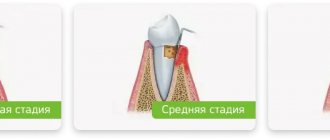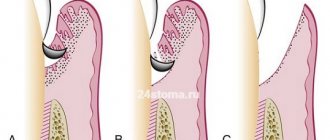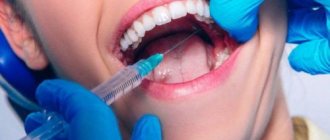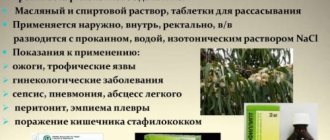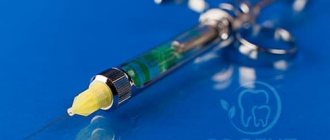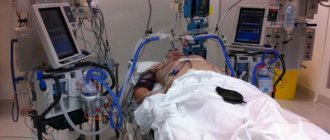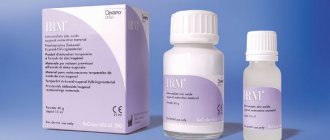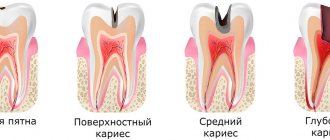Surgical and therapeutic dentistry currently widely use gingival dressings for the purpose of therapeutic and protective effects on the damaged area of the patient’s alveolar process.
A wide variety of dental dressings facilitates the work of dentists and increases the level of patient comfort when it is necessary to apply any type of bandage.
Types of periodontal dressings
Depending on the purpose, a dental bandage can be:
- isolating - applied after surgery, protects the surface of the wound from external factors that aggressively affect the condition of the damaged part of the gum;
- medicinal - containing drugs with different mechanisms of action on foci of inflammation. These can be medications that have an antiseptic, analgesic, antimicrobial, keratoplasty (promoting the restoration of soft tissue) effect.
Types of periodontal dressings - preparations for gingival applications
There are several classifications of the applications under consideration:
1. Depending on the purpose:
- Medicinal. They help to achieve maximum effectiveness when administering drugs into inflamed pathological pockets, gums, interdental spaces, etc.
- Insulating. Cover the operated area: food and liquid can easily injure the area and cause bleeding and inflammation.
2. Based on their composition, the dressings in question can be divided into several groups:
Soft
They are quite popular . Making such dressings is quite easy: you need a bandage/gauze and ointment (gels are used less often). The main medication may be tetracycline, heparin, betadine or indomethacin ointments. Among gels, doctors often make a choice between solcoseryl, curiosin and actovegin.
Positive aspects of soft bandages:
- low cost
- ease of manufacture.
The disadvantage is the difficulty in fixing the textile material to the gum.
Semi-solid
Ointments that are applied to the group of dressings in question must be oil-based. The required preparation is produced by mixing dentin paste and ointment. The resulting product is quickly applied to the textile and pressed to the desired area. For a strong fixation, the patient should clench his teeth and sit in this position for 5-7 minutes.
Pros of semi-solid dressings:
- due to hardening, they are easy to fix on the alveolar process.
Negative sides:
- manufacturing takes time, and the list of possible drugs that can be applied to a semi-solid dressing is very limited.
Solid
Here, doctors can use ready-made products (septopack) or make applications themselves. In the second case, you need to work with special impression agents: repin, dentol.
If applied incorrectly, hard bandages can irritate the mucous membrane and interfere with tongue movements. In the first 20 minutes after applying the application, you should make sure that there are no obstacles to articulatory movements. If errors are identified, the doctor must make adjustments by cutting off unnecessary parts.
Adhesive compositions
The dressings in question are made from synthetic (cyanoacrylate, polyurethane) substances . Today, a group of medical adhesives based on cyanoacrylate is more often used: KL-3, MK-9, SK-2, MK-14I. Such materials are firmly fixed even in a humid environment, and due to their biocompatibility with mucous membranes, allergic reactions almost never occur.
If there is a problem with tooth mobility, adhesive compositions will also be useful: they can briefly secure a shaky crown. If there are inflammatory reactions in periodontal tissues, experts advise turning to the MK-14I application: it contains components that help destroy harmful microorganisms. In addition, with the drug MK-14I, wounds heal faster.
Despite the effectiveness and speed of the applications under consideration, they also have disadvantages:
- the adhesive film adheres very tightly to the tissues of the body, causing destructive reactions at the cellular level.
For the full treatment of the consequences caused by periodontitis, adhesive compositions alone are not enough. However, if there is a need to reliably isolate the damaged area, medical glue will do a better job than any solid bandage.
Collagen films.
Can be used in the postoperative period, or during the therapeutic treatment of periodontitis. These dressings are impregnated with a variety of medications: chlorhexidine, dexamethasone, lidocaine.
Thanks to the presence of anesthetics, collagen films help eliminate tooth sensitivity during professional cleaning.
Gingival dressings ex tempore.
They contain several substances that are mixed on dental glass with a medical spatula and applied to defective areas. Such applications often include white clay, zinc oxide and dentin. Paraffin is used less often. Sometimes oils, oil solutions, herbal remedies, vitamins, etc.
These dressings help relieve swelling, reduce pain, and speed up the healing of the wound surface. For mass use, such dressings are made in advance, wrapped in foil and stored in the refrigerator. Before application, they are softened with hot water.
The disadvantages of ex tempore dressings are the same as those of solid applications.
Types of material for therapeutic periodontal dressings
Based on their composition, dental medicinal dressings are divided into several groups:
- Soft are the most common dressings, characterized by speed of production and affordable price. However, it is quite difficult to fix such applications; the duration of their presence in the patient’s oral cavity is quite short. The gel or ointment is applied to a strip of textile material (bandage, gauze), evenly distributed over its entire surface and fixed by throwing the bandage over the surface of the dental crown.
- Semi-solid - used less frequently; there are certain requirements for the use of forms of medicinal preparations: ointments must have a fatty base. The composition of the medicine and paste mixed on a special glass is distributed on a textile basis and transferred to the desired location of the alveolar process. Fixation is achieved by compressing the patient's teeth for 3 to 5 minutes.
- Hard - there are ready-made periodontal dressings and those that are made independently using materials used for taking impressions - repin, dentol. The main feature when working with such material is to use dry and sterile instruments; moisture on the preparation is unacceptable. In the oral cavity, the hard bandage remains plastic for 2 - 3 minutes.
- Adhesive - made on the basis of polyurethane, they are highly hypoallergenic. After polymerization, a plastic film is formed that does not interfere with the oxygen saturation of soft tissues.
- Collagen - widely used after surgery and as therapy for periodontitis. Collagen films are impregnated with various compositions of drugs.
CHARACTERISTICS OF GROUPS OF BANDAGES
An analysis of the pharmaceutical market offers led to the conclusion that the classification of periodontal dressings is somewhat behind the times, and we propose our own classification (groups 1, 2, 3, 6 are described in many textbooks on periodontology and are widely used, and 4- I and the 5th group are included by us and belong to the more modern ones).
Classification of periodontal dressings (L. R. Mukhamedzhanova, D. R. Musharapova, 2010)
1. Soft periodontal dressings. 2. Semi-solid periodontal dressings. 3. Hard periodontal dressings. 4. Adhesive compositions. 5. Collagen films. 6. Dressings made ex tempore.
Soft periodontal dressings
The most commonly used group of periodontal dressings. It is characterized by relative ease of manufacture and low cost, but fixing such periodontal dressings on periodontal tissues is quite difficult. This bandage is applied for no more than 5–7 minutes. For the manufacture of soft periodontal dressings, soft dosage forms are used: water-soluble and fat-soluble ointments, gels, pastes. The most commonly used soft dosage forms are tetracycline ointment 1 and 3%, betadine ointment, methyluracil ointment 10%, heparin, butadione, indomethacin ointments.
Gels: solcoseryl, curiosin, actovegin. Cotton wool, bandage (gauze) or other textile material can be used as a carrier.
There are 2 ways to apply a bandage :
- A soft dosage form is applied to a textile carrier of the required size and distributed evenly over the entire surface with a spatula. Then it is fixed on the alveolar process so that the central part of the periodontal bandage is thrown over the cutting edge of the teeth, and the marginal and alveolar gums are covered. The size of the textile carrier must be calculated in such a way that the periodontal bandage covers the border on the vestibular and oral sides.
- Prepare 2 cavities from a textile carrier measuring 3 x 0.5 cm, apply a soft dosage form to them and attach them to the vestibular and oral surfaces of the alveolar process. With this method, the bandage is held in place by adhesive mechanisms.
Semi-solid periodontal dressings
This group of periodontal dressings is used much less frequently because it requires a certain amount of time. These dressings are well fixed on the alveolar process due to the hardening effect, however, the range of dosage forms used for these purposes is very limited: only ointments made on a fatty (lanolin, petroleum jelly) basis. Manufacturing method: on a plateau, mix dentin paste and ointment in equal quantities to the consistency of thick sour cream. Then this mass is quickly transferred to a pre-prepared textile carrier of the required size and fixed on the alveolar process. The patient is asked to close his jaws and sit for 3–7 minutes. During this time, the bandage hardens.
This bandage stays in the mouth for 3–7 hours, then begins to crumble. The appearance of crumbs is a signal to remove the bandage.
Solid periodontal dressings
Solid periodontal dressings are divided into 2 groups: 1. Ready-made periodontal dressings (septopack). 2. Hard 2-layer dressings made using dental impression materials (repin, dentol).
Method for making a septopack : when working with these preparations, use only a dry and sterile spatula; A small amount of paste taken with this tool should be given a conical or spherical shape, depending on the subsequent use. At the same time, moisture should not come into contact with the preparation. It remains plastic in the oral cavity only for 2–3 minutes after application to the treated area, and hardens within half an hour. Exposure time - up to a day.
Adhesive compositions
One of the promising groups of periodontal dressings. Adhesive compositions include adhesive dressing KL-3, which is an adhesive composition based on polyurethane, is a non-toxic, biologically compatible preparation, and is autosterile. When applied to the gum mucosa, it polymerizes to form a porous, highly plastic film.
Collagen films
Collagen films are self-absorbable adhesive films impregnated with various medicinal substances, for example, Diplen-Denta M with metronidazole, Diplen-Denta L with lincomycin, Diplen-Denta HD with chlorhexidine and dexamethasone, Diplen-Denta LH with lidocaine and chlorhexidine. The film is transparent, adheres well to the moist surface of the oral mucosa and does not cause discomfort in patients. It can be used as a periodontal dressing after interventions on periodontal tissues, as well as as an independent means of pathogenetic therapy. The duration of treatment varies from 7 to 20 days depending on the severity of the disease with daily applications 1 or 2 times a day. "Diplen-Denta LH" is used for surface anesthesia before the removal of supra- and subgingival dental plaque and curettage of periodontal pockets, as well as in the treatment of lesions of oral tissue with severe pain symptoms (wounds, aphthae, ulcers, bedsores from dentures, etc.) .
Method for making a bandage: the film removed from the package is cut into strips 5 cm long and about 1 cm wide and applied with the adhesive (bottom) side to the gum in the area of all teeth. The remaining film dissolves in the oral cavity and is not necessary to remove.
Ex tempore dressings
The “creative group” of periodontal dressings allows us to take into account the individual characteristics of the disease. There are various prescriptions for periodontal dressings - here is one example:
- ZnO 40.0
- Rosin 45.0
- Tannin 10.0
- Zinc acetate 4.7
- White clay 2.5
- Sulfanilamide 2.0
- Asbestos fibers 1.0
- Ascorbic acid 0.1
- Vitamin P 0.1
The basis of most therapeutic dressings is zinc oxide, dentin, and white clay. The liquid ingredients in different recipes are different: clove, corn, sea buckthorn oil, rosehip oil, oil solutions of vitamins A, E. Substances with different mechanisms of action are introduced into medicinal dressings: vitamins A, E, C, P, group B, enzymes, glucocorticosteroids, preparations of pyrimidine bases, extracts and extracts of medicinal herbs, propolis, sulfa drugs, antibiotics and other biologically active drugs. Under their influence, the contamination of periodontal pockets with microorganisms is reduced, and a pronounced anti-inflammatory, antimicrobial, hyposensitizing, keratoplasty, analgesic and regeneration-stimulating effect is manifested.
Application of therapeutic periodontal dressing
The application of a periodontal dressing is necessarily preceded by surgical or conservative treatment of gums, periodontal pockets, etc., the purpose of such applications is to prolong the effect of medications on periodontal tissue.
Preparation for applying a dressing occurs immediately before the dressing procedure.
It is important to ensure that the bandage is positioned correctly in the oral cavity - it should completely isolate the periodontal pocket from external irritants and not cause discomfort to the patient.
How to apply a bandage
Before proceeding directly to applying a gingival dressing, consider:
- Presence of anesthetic substances;
- Degree of wound protection;
- Anti-inflammatory effect.
The application process consists of the following steps:
- The doctor professionally cleans the tooth surface, removing deposits;
- The gingival margin is treated with antiseptics;
- After this, the bandage, regardless of its type, is applied so that it fits closely to the gingival margin and cervical part. In this way, periodontal pockets are isolated.
The doctor must make sure that the patient is able to articulate normally. If defects remain after the application of medicinal products, they are corrected: parts that interfere with the person’s ability to speak are cut off.
Duration of wearing from several minutes to three days. Soft bandages are most often used. When a longer period is needed to isolate the wound from the environment, for 3-7 days, rigid/elastic products are used. The procedure can be repeated 2-3 times.
Requirements for therapeutic periodontal dressings
The combination of comfort and therapeutic effect puts forward some requirements for the quality composition of periodontal dressings:
- their organolepticity - the presence of the material in close proximity to the taste buds implies the acceptability of the ratio of smell, appearance, color;
- compatibility - the material should not react with the components of the medicinal product;
- stability - determined by the ability to maintain the integrity of the bandage for a sufficient amount of time while in the moist environment of the patient’s oral cavity.
The therapeutic periodontal dressing can remain in place from several hours to several days.
Overlay Stages
The method of applying a gum pack is determined by its type and composition. The easiest way to work is with a soft textile-based dressing: the doctor uses a spatula to apply the medicine to a piece of bandage or gauze and places the textile on the gum.
It is much more difficult to apply adhesive compositions. To do this you need:
- stop bleeding from the wound;
- dry the surface of the teeth and mucous membrane;
- the composition is applied to the wound surface area with a trowel very quickly, since the glue dries within a maximum of 7 minutes.
Application of therapeutic dressings
Over the past years, periodontology has widely used the application of therapeutic dressings for periodontal diseases. Somewhat earlier, such dressings were called “gingival pack”, “periodontal pack”, and also “surgical cement”. The purpose of applying bandages is to ensure long-term therapeutic effects of medications that were introduced into periodontal pockets during conservative treatment. Without the use of dressings, drugs are easily washed away by saliva, which weakens the effect of treatment. Also, periodontal dressings are used after surgical intervention to protect the wound surface from trauma during eating and possible infection with the contents of the oral cavity.
